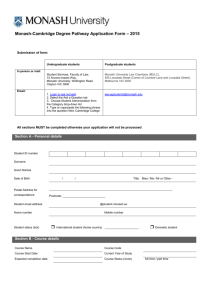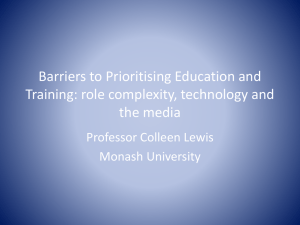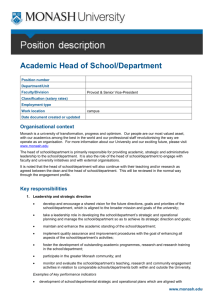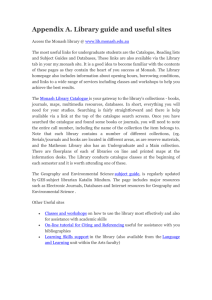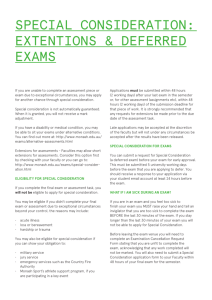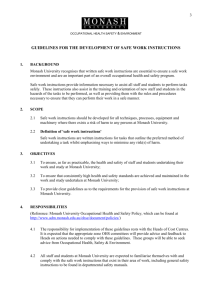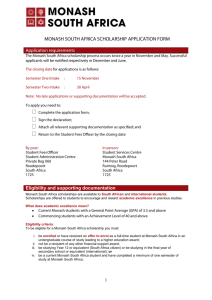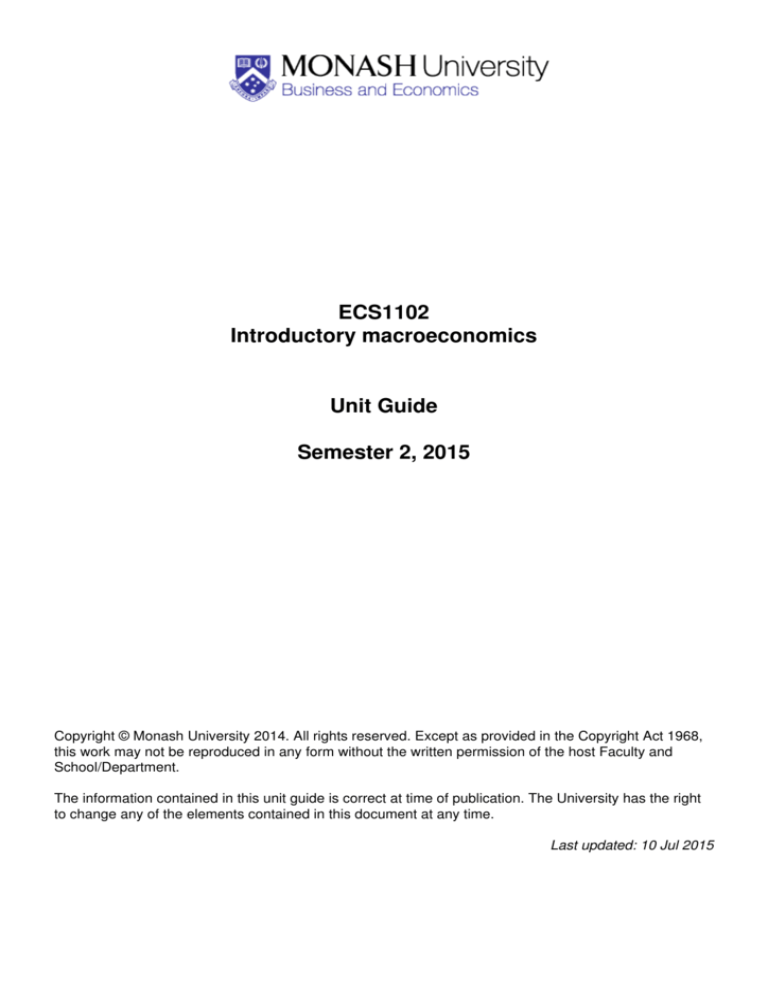
ECS1102
Introductory macroeconomics
Unit Guide
Semester 2, 2015
Copyright © Monash University 2014. All rights reserved. Except as provided in the Copyright Act 1968,
this work may not be reproduced in any form without the written permission of the host Faculty and
School/Department.
The information contained in this unit guide is correct at time of publication. The University has the right
to change any of the elements contained in this document at any time.
Last updated: 10 Jul 2015
Table of Contents
ECS1102 Introductory macroeconomics - Semester 2, 2015................................................................1
Mode of Delivery..............................................................................................................................1
Workload requirements....................................................................................................................1
Unit Relationships............................................................................................................................1
Prohibitions..........................................................................................................................1
Chief Examiner(s)........................................................................................................................................1
Campus Lecturer(s).....................................................................................................................................1
South Africa.....................................................................................................................................1
Tutor(s)........................................................................................................................................................1
South Africa.....................................................................................................................................1
Your feedback to Us....................................................................................................................................2
Previous Student Evaluations of this Unit....................................................................................................2
Academic Overview...................................................................................................................................3
Learning Outcomes.........................................................................................................................3
Unit Schedule.............................................................................................................................................4
Teaching Approach..........................................................................................................................4
Assessment Summary.....................................................................................................................5
Hurdle Requirements...........................................................................................................6
Second marking...................................................................................................................6
Return of final marks............................................................................................................6
Exam viewing.......................................................................................................................6
Assessment criteria..............................................................................................................6
Assessment Requirements......................................................................................................................7
Assessment Tasks...........................................................................................................................7
Assessment task 1...............................................................................................................7
Assessment task 2...............................................................................................................7
Assessment task 3...............................................................................................................7
Assessment task 4...............................................................................................................9
Examination(s).............................................................................................................................................9
Examination 1..................................................................................................................................9
Learning resources....................................................................................................................................10
Feedback to you........................................................................................................................................10
Extensions and penalties...........................................................................................................................10
Returning assignments..............................................................................................................................10
Resubmission of assignments...................................................................................................................10
Referencing requirements.........................................................................................................................10
Assignment submission.............................................................................................................................10
Hard copy submission...................................................................................................................10
Online submission.........................................................................................................................11
Prescribed text(s) and readings.....................................................................................................11
Recommended text(s) and readings..............................................................................................11
Other Information....................................................................................................................................12
Policies..........................................................................................................................................12
Graduate Attributes Policy.................................................................................................12
Student Charter.........................................................................................................................................12
Student services........................................................................................................................................12
Monash University Library.........................................................................................................................12
Moodle 2....................................................................................................................................................13
Disability Liaison Unit................................................................................................................................13
ECS1102 Introductory macroeconomics - Semester 2, 2015
An introduction to the study of economics from a macroeconomic perspective including the following
areas of study: trade in a global village, GDP as National Income and Aggregate Expenditure, savings
and investment, unemployment, money and the South African monetary system, aggregate demand and
supply in the short and long run, monetary and fiscal policy, including the related debates in South Africa
as an open economy and as a major economy in Africa.
Mode of Delivery
South Africa (Day)
Workload requirements
Minimum total expected workload to achieve the learning outcomes for this unit is 144 hours per
semester typically comprising a mixture of scheduled learning activities and independent study.
Independent study may include associated readings, assessment and preparation for scheduled
activities. The unit requires on average three/four hours of scheduled activities per week. Scheduled
activities may include a combination of teacher directed learning, peer directed learning and online
engagement.
See also Unit timetable information
Unit Relationships
Prohibitions
ECB1102, ECF1200, ECG1102, ECW1102
Chief Examiner(s)
Dr Kwame Osei-Assibey
Campus Lecturer(s)
South Africa
Prof Olusegun Akanbi
Contact hours: TBA
Tutor(s)
South Africa
TBC
Contact hours: TBA
1
ECS1102 Introductory macroeconomics - Semester 2, 2015
Your feedback to Us
Monash is committed to excellence in education and regularly seeks feedback from students, employers
and staff. One of the key formal ways students have to provide feedback is through the Student
Evaluation of Teaching and Units (SETU) survey. The University’s student evaluation policy requires that
every unit is evaluated each year. Students are strongly encouraged to complete the surveys. The
feedback is anonymous and provides the Faculty with evidence of aspects that students are satisfied
and areas for improvement.
For more information on Monash’s educational strategy, see:
www.monash.edu.au/about/monash-directions/ and on student evaluations, see:
www.policy.monash.edu/policy-bank/academic/education/quality/student-evaluation-policy.html
Previous Student Evaluations of this Unit
If you wish to view how previous students rated this unit, please go to
https://emuapps.monash.edu.au/unitevaluations/index.jsp
2
Academic Overview
Learning Outcomes
The learning goals associated with this unit are to:
1. gain an insight into the product, money, labour and foreign exchange markets
2. develop skills in the application of economic principles to wider social issues
3. gain knowledge and understanding of the South African and African economies and their
operation in an international environment
4. acquire the basis for more advanced studies in economics
5. demonstrate in individual summative assessment tasks the acquisition of a comprehensive
understanding of the topics covered.
3
Unit Schedule
Week
Activities
Assessment
0
Unit site may be viewed during orientation week.
Teaching support begins in week 1.
No formal assessment or activities are
undertaken in week 0
1
How the economy works: Key macroeconomic
concepts. Chapter 1: Ten lessons from Economics
National income, expenditure and the circular flow.
Chapter 24: Measuring a nations Income
2
Production, growth and the cost of living Chapter 25:
Measuring the cost of Living Chapter 26: Production
and growth
3
Savings, investment and the financial system Chapter
27: Savings, investment and the financial system
Unemployment Chapter 28: The natural rate of
unemployment
4
Semester Test 1 (17 August 2014)
5
Money and Inflation Chapter 29: The monetary system
Chapter 30: Inflation: Its causes and costs
6
International trade and exchange rates Chapter 31:
Open Economy Macroeconomics: Basic concepts
7
The open economy Chapter 32: A macroeconomic
theory of the Open Economy
8
Semester test 2 (14 September 2014)
9
Aggregate demand and aggregate supply Chapter 33:
Aggregate demand and Aggregate supply
10
Monetary and fiscal policies Chapter 34: The influence Assignment Due date: October 5 ,2015
of Monetary and Fiscal Policies on Aggregate Demand at 1500hrs MSA time
11
Government policy: Inflation and unemployment
trade-off Chapter 35: The Short-Run Trade-Off
Between Inflation and Unemployment
12
Linking it together - macroeconomic policy debates
Chapter 36: Five Debates Over Economic Policy
MCQ and written questions based on
weeks 1-3
MCQ and written questions based on
weeks 5-7
SWOT VAC
No formal assessment is undertaken
SWOT VAC
Examination period
LINK to Assessment Policy:
http://policy.monash.edu.au/policy-bank/
academic/education/assessment/
assessment-in-coursework-policy.html
Teaching Approach
Lecture and tutorials or problem classes
4
Unit Schedule
This unit will be taught as a two-hour class session and a one hour tutorial each week for 12 weeks. This
may include lectures, tutorials, seminars, discussion forums, etc.
This unit requires a disciplined and consistent approach to study. Your aim should be to gain a detailed
understanding of the unit material. Much of the material is conceptual and requires precise definition and
usage of economic terminology. Students who do not understand the material usually answer questions
by making assertions (unsupported), or by presenting a vague, ‘commonsense’ discussion of the
problem. At this level of study, answers must be argued and explained using the relevant theoretical
structure and, if appropriate, include supporting evidence.
Learning of this unit is cumulative. Each topic builds on the preceding material. You must therefore study
it as a whole rather than concentrating on selected topics.
The following is a suggested approach to the study of the unit:
1. Make a resolution that your aim is to really understand the material in the unit rather than simply
trying to memorise enough to pass the assessment.
2. Begin your study of each topic by reading through the weekly learning objectives and comments.
This will give you an overall appreciation of the structure of the topic and alert you to the main areas for
study. Take note of the learning objectives listed at the start of each week’s study material. While the
textbook and other readings contain many additional issues/topics that it would be useful to read, the
assessments in the unit will be based on an understanding of these learning objectives.
3. Use the learning objectives as a guide for your note taking. You will get additional guidance from the
weekly lecture notes available from the MUSO website for the unit.
4. Read the appropriate sections of the text. Read right through the material initially and then
commence a detailed study of each section. Make sure you understand each section of the material
before proceeding to the next.
There will be 3 hours class contact per week during the semester. In addition, students should plan to
spend an additional 108 hours during the semester (9 hours per weeks for 12 weeks) in study for this
unit. This includes time spent on- preparing and completing assessment tasks, preparing for and
completing assessment tasks, general study, revision and exam preparation
Assessment Summary
Within semester assessment: 40%
Examination: 60%
Assessment Task
Value
Due Date
Semester Test 1
10%
Monday 17 August 2015
Semester Test 2
10%
Monday 14 September 2015
Assignment
10%
Monday October 5, 2015 at 1500hrs
Class and Tutorial attendance and presentations
10%
From Week 1 to Week 12
Examination 1
60%
To be advised
5
Unit Schedule
Hurdle Requirements
There is a hurdle requirement in this unit. The learning outcomes in this unit require students to
demonstrate in the individual summative assessment tasks a comprehensive understanding of the topics
covered in the unit. This is demonstrated by the requirement that the student must attain a mark of at
least 40% in the final examination.
A student’s final mark is normally the sum of the marks obtained in all of the individual assessment items
in the unit. Where a student fails the unit solely because of failure to satisfy the hurdle requirement a
mark of 48 will be returned for the unit.
Refer to faculty website for full details:
http://www.buseco.monash.edu.au/asg/agu/policies/methods-of-assess.html
Second marking
Where an assessment task is given a fail grade by an examiner, that piece of work will be marked again
by a second examiner who will independently evaluate the work, and consult with the first marker. No
student will be awarded a fail grade for an assessment task or unit without a second examiner confirming
the result.
Note: Exceptions to this are individual pieces of assessment contributing 10% or less of the final mark,
unless the total of such pieces exceeds 30% of the final mark.
Return of final marks
Faculty policy states that 'the final mark that a student receives for a unit will be determined by the Board
of Examiners on the recommendation of the Chief Examiner taking into account all aspects of
assessment'.
The final mark for this unit will be released by the Board of Examiners on the date nominated in the
Faculty Calendar. Student results will be accessible through the my.monash portal.
Exam viewing
For Monash policy and process on exams viewing, contact the School Administrator of School of
Business and Economics
Assessment criteria
Assessment Criteria Grading Descriptors available at:
http://www.policy.monash.edu/policy-bank/academic/education/assessment/
6
Assessment Requirements
Assessment Tasks
•
Assessment task 1
Title:
•
Semester Test 1
Due date:
Monday 17 August 2015
Details of task:
Conducted in lectures during week 4. This tests learning objectives from weeks 1-3. The
test will contain 20 multiple choice questions and also some discussion questions.
Students will have 90 minutes to complete the test. It is a closed book test. This is an
individual task.
Weighting/Value:
10%
Estimated return date:
We aim to return test within 3 weeks.
Learning objectives assessed:
Tests learning objectives from weeks 1 – 3
Assessment task 2
Title:
•
Semester Test 2
Due date:
Monday 14 September 2015
Details of task:
Conducted in lectures during week 8. This tests learning objectives from weeks 5-7. The
test will contain 20 multiple choice questions and some discussion questions. Students
will have 90 minutes to complete the test. It is a closed book test.
Weighting/Value:
10%
Estimated return date:
We aim to return test within 3 weeks.
Learning objectives assessed:
Tests learning objectives from weeks 5 – 7
Assessment task 3
Title:
Assignment
Due date:
Monday October 5, 2015 at 1500hrs
Details of task:
Details of assignment is available on Moodle and student's shared drive
Weighting/Value:
10%
Presentation requirements:
7
Assessment Requirements
♦ Assignment should be typed using an appropriate font (preferably Arial, Times
New Roman, Calibri and Helvetica). Font size should be a minimum of 12 (apart
from foot notes)
♦ Diagrams can be drawn by free-hand although computer aided diagrams are
preferred. Pencils can be used to draw diagrams
♦ Check your spelling, punctuation and grammar before submitting your assignment.
♦ Attach a bibliography. Use an acceptable form of citation for footnotes and
bibliography. Incomplete or inaccurate bibliographies will be penalized.
Assignments submitted without a bibliography will not be accepted.
♦ It is accepted that students will assist each other with problems associated with
their studies and discuss issues with each other. Sometimes advice may be
sought by one student from others relating to minor issues of comprehension,
interpretation or further explanation of a point made by the lecturer during a
class. Students, however, must undertake all assigned work,
independently (No group work).
♦ Presentation is an important part of all written work and a skill, which needs to be
developed. Assignments, which have serious deficiencies in this regard, will be
penalized.
♦ Students can clarify their doubts regarding the questions asked in the assignment
prior to submission. However please don’t expect us to evaluate/informally mark
your assignment before submission. Moreover, once an assignment has been
submitted and graded there is no provision for rewriting and reassessment.
♦ Remember DO NOT PLAGIARISE.
http://policy.monash.edu.au/policy-bank/academic/ education/conduct/plagiarism-policy.htm
Estimated return date:
Marks will be returned to students via tutorials within 3 weeks after the due date
Criteria for marking:
The following points represent the general guidelines to assist you in completion of the
assignments. The marking rubric is available on Moodle and the student shared drive
Please make every effort to present the assignments in word processed form, but
diagrams can be drawn by hand. This will enhance your work and make it easier for
examiners to read and assess. Attempt to fully utilise your acquired knowledge in
answering each assignment. Also, clearly acknowledge your sources of information in an
appropriate manner.
The assignment will be judged on the basis of:
♦ the depth of your understanding of the topic and the issues involved
♦ your ability to determine the requirements of the question and present the material
in a clear, logical and well-structured format
♦ use of appropriate theoretical framework
♦ proper use of footnotes and reference list
♦ quality of presentation – involving correct spelling, grammar, good writing style and
neat professional presentation is expected.
Learning objectives assessed:
This assignment is designed to assess your ability to apply economic concepts to real
world applications. It addresses the learning objectives from Weeks 6 & 7.
Questions 1 and 2 relate to content and skills covered in Week 6 of the Weekly Study
Program, Chapter 31 of Gans et al. (2012)
Question 3 relates to content and skills covered in Week 7 of the Weekly Study Program,
Chapter 32 of Gans et al. (2012).
Submission details:
8
Assessment Requirements
Students will submit their assignments in the assignment drop box. Only under
exceptional circumstances will the lecturer accept online submission.
Penalties for late lodgement:
A late assignment, that is assignments submitted after the due date and where no
extension has been granted, will be accepted, but in fairness to students who present
their work on time, a penalty will be levied. A maximum penalty of 10% of the total mark
allocated to this assessment will be deducted for each day that it is late. Please note that
this policy applies to this unit only; other lecturers may take a different approach
Assessment coversheet:
Work submitted for assessment MUST be accompanied by a completed and signed
assignment coversheet, available at URL:
http://www.buseco.monash.edu.au/student/forms/assessment-coversheet.doc
NO assignment will be accepted or marked if it is not accompanied by a
signed Assignment coversheet
•
Assessment task 4
Title:
Class and Tutorial attendance and presentations
Due date:
From Week 1 to Week 12
Details of task:
Lecture attendance will be randomly taken during the semester. This will be done at least
four times during the semester. Lecture attendance would be mainly assessed by
unannounced written quizzes and or by ticking of attendance lists.
Tutorial attendance will be taken during every tutorial classes.
Weighting/Value:
10%
Estimated return date:
Examination(s)
• Examination 1
Weighting:
60%
Length:
3 hours
Type (open/closed book):
Closed book
Hurdle requirements:
There is a hurdle requirement for this unit. Students must attain a mark of at least 40% in
the final summative assessment task of the unit. A student final mark is the sum of the
marks obtained in all the individual assement items in the unit. Where a student fails the
unit solely because of failure to satisfy the hurdle requirement, a maximum mark of 48 will
be returned for the unit.
Electronic devices allowed in the exam:
None
9
Assessment Requirements
Learning resources
Monash Library Unit Reading List (if applicable to the unit)
http://readinglists.lib.monash.edu/index.html
Feedback to you
Types of feedback you can expect to receive in this unit are:
• Informal feedback on progress in labs/tutes
• Graded assignments without comments
• Test results and feedback
• Other: Students will receive feedback in the following ways-1. In returned assignments 2. In
lectures and tutorials 3. During consultations
Extensions and penalties
All applications for an extension of the time allocated to an assessment task must be made in writing to
the Unit Leader. Approval, if granted, will be in writing and will be recorded on the Faculty Assignment
cover sheet accompanying the assessment task by the responsible lecturer/tutor. A late submission
will incur a penalty of 10% of marks for each day up to 10 days.
Returning assignments
All marked assignments with relevant comments should be returned within 3 weeks of submission
deadline. Assignments should be collected from the department. Marks obtained for the class test will
be made available to students and the answers to test questions will be dicussed during tutorials.
Resubmission of assignments
No resubmission of assignments is permitted
Referencing requirements
Work submitted for this assessment must follow the Faculty Style as outlined in the Faculty Q Manual.
Copies of this Manual can be obtained at the bookshop or online
at: http://www.buseco.monash.edu.au/publications/qmanual/. To build your skills in citing and
referencing, and using different referencing styles, see the online tutorial Academic Integrity:
Demystifying Citing and Referencing at: www.lib.monash.edu.au/tutorials/citing/.
Assignment submission
Hard copy submission
Assignment must include a cover sheet. No assignment will be marked or accepted if it does not come
with a coversheet. The coversheet is accessible via the Monash portal page located
at http://my.monash.edu.au under the heading ‘Learning and teaching tools.’ Please keep a copy of
tasks completed for your records. You will be notified by the unit instructor on where to locate the
assignment drop boxes prior to assignment deadlines
10
Assessment Requirements
Online submission
Only under extreme and exceptional circumstances will the lecturer accept online submission.
Prescribed text(s) and readings
Gans, J., King, S., Stonecash, R. & Mankiw, N.G. (2012). Principles of Economics, 5th edition, Cengage
Learning Australia Pty Ltd.
Recommended text(s) and readings
Study guide text
Tennant, J. & Hakes, D. (2012). Principles of Macroeconomics Study Guide, 5th edition, Cengage
Learning Australia Pty Ltd.
Recommended text(s)/readings
Krugman, P., Wells, R., and Graddy, K., (2013), Essentials of Economics. 3rd Edition, Worth Publishers
Hubbard, G., and O’Brien, A., (2012), Economics. 4th Edition, Prentice Hall.
McEachern, W. A. (2012), Economics: A Contemporary Introduction. 10th Edition, Cengage Learning.
The Prescribed Text is sufficient to complete your study of this unit. If you find some area of the
Prescribed Text difficult to understand, you may want to consult an alternative text.
All standard textbooks in microeconomics and macroeconomics generally cover the same principles and
ideas. The major difference between them is in their depth of explanation and their use of practical
examples and applications of concepts.
Please contact your unit coordinator for advice in choosing additional reading if required.
11
Other Information
Policies
Monash has educational policies, procedures and guidelines, which are designed to ensure that staff and
students are aware of the University’s academic standards, and to provide advice on how they might
uphold them. You can find Monash’s Education Policies at:
www.policy.monash.edu.au/policy-bank/academic/education/index.html
Key educational policies include:
• Student Academic Integrity Policy and Student Academic Integrity: Managing Plagiarism and
Collusion Procedures ;
• Assessment in Coursework Programs;
• Special Consideration;
• Grading Scale;
• Discipline: Student Policy;
• Academic Calendar and Semesters;
• Orientation and Transition; and
• Academic and Administrative Complaints and Grievances Policy.
Graduate Attributes Policy
http://www.policy.monash.edu/policy-bank/academic/
education/management/monash-graduate-attributes-policy.html
Student Charter
www.opq.monash.edu.au/ep/student-charter/monash-university-student-charter.html
Student services
The University provides many different kinds of support services for you. Contact your tutor if you need
advice and see the range of services available at http://www.monash.edu.au/students
You can also access important information from the Faculty of Business and Economics current students
page http://www.buseco.monash.edu.au/student/
Caulfield and Clayton students wishing to further develop English language skills in a fun group
environment can join a Conversational English Program. You can access these programs at
http://www.monash.edu/students/conversational-english/
Monash University Library
The Monash University Library provides a range of services, resources and programs that enable you to
save time and be more effective in your learning and research. Go to www.lib.monash.edu.au or the
library tab in my.monash portal for more information.
12
Other Information
Moodle 2
All unit and lecture materials, plus other information of importance to students, are available through the
virtual learning environment Moodle site. You can access Moodle via the my.monash portal.
Where to go for help
If you're stuck, confused or simply not sure how to approach Moodle, there are a number of Moodle
resources that you can tap into.
Disability Liaison Unit
Students who have a disability or medical condition are welcome to contact the Disability Liaison Unit to
discuss academic support services. Disability Liaison Officers (DLOs) visit all Victorian campuses on a
regular basis.
• Website: http://www.monash.edu/equity-diversity/disability/index.html
• Telephone: 03 9905 5704 to book an appointment with a DLO;
• Email: dlu@monash.edu
• Drop In: Equity and Diversity Centre, Level 1, Building 55, Clayton Campus.
13

